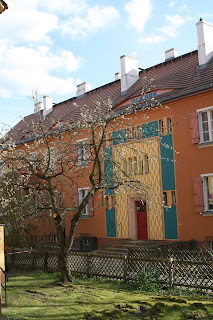The garden city housing estate Gartenstadt Falkenberg also known by the name Paintbox estate (Tuschkastensiedlung) is situated in Berlin district Treptow/Köpenick. It was the first of six Berlin Modernist Housing Estates (among with Schillerpark, Wohnstadt Carl Legien, Großsiedlung Britz (Hufeisensiedlung), Siemensstadt and Weiße Stadt), which are featured on the UNESCO world heritage list. Built between 1913 and 1915 by architect Bruno Taut it is exceptional not only because of its architectural and historic importance, but also due to their good state of preservation.
The architects of the modern movement responded to the lack of housing on the eve of the First World War at the highest architectural level: modern, affordable flats with kitchens, bathrooms and balconies, in houses without backyards or side wings, which provided light, air and space for the inhabitants. The high quality of the architecture, its formal language, floor plans and urban design became a model for the entire 20th century.
It is famous for its colourful façades, at that time the cheapest and most successful method of providing the prefabricated houses with individuality. However, Taut's choice of colours was sometimes very bold and unusual, at least for the estate houses exterior.
Berlin Senate Department for Urban Development and the Environment offers guided tours by bus and on foot, with apartment visits to all six housing estates, plus a seventh, which is not on the UNESCO-list, but still the most visited modernist settlement: Onkel Toms Hütte, designed by Bruno Taut, Hugo Häring and Otto Rudolf Salvisberg. More info can be found at www.stadtentwicklung.berlin.de
Layout of the settlement from the library of the TU Berlin
The architects of the modern movement responded to the lack of housing on the eve of the First World War at the highest architectural level: modern, affordable flats with kitchens, bathrooms and balconies, in houses without backyards or side wings, which provided light, air and space for the inhabitants. The high quality of the architecture, its formal language, floor plans and urban design became a model for the entire 20th century.
Houses at Gartenstadtweg
Row houses at Akazienhof
What was also remarkable for that time was the decision to hire a renowned landscape architect like Ludwig Lesser to design the estate’s gardens and public spaces. Alongside with Taut and Lesser another renowned architect and urban planner Heinrich Tessenow was working at Falkenberg (only responsible for the building at am Falkenberg 119).
Houses am Falkenberg
Houses at Gartenstadtweg
Photo: Olga Voronova ©
Berlin Senate Department for Urban Development and the Environment offers guided tours by bus and on foot, with apartment visits to all six housing estates, plus a seventh, which is not on the UNESCO-list, but still the most visited modernist settlement: Onkel Toms Hütte, designed by Bruno Taut, Hugo Häring and Otto Rudolf Salvisberg. More info can be found at www.stadtentwicklung.berlin.de

















No comments:
Post a Comment